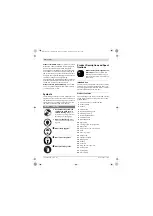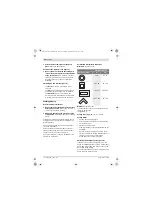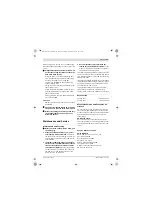
English |
21
Bosch Power Tools
1 609 929 X93 | (10.2.11)
Securing the Machine (Transport Position)
(see figure C2)
– Guide the tool arm
28
down via the handle
3
until you can securely hook the hook
14
of
the securing chain
15
to the tool arm.
For additional information on transport, see
page 23.
Adjusting the Cutting Angle
(see figure D)
The miter angle can be set in a range from 0° to
45°.
Frequently used mitre angles are identified on
the angle stop
10
with appropriate markings.
The 0° and 45° position are set at the respec-
tive end stop.
– Loosen the locking screws
11
for the angle
stop with the supplied ring spanner
13
(15 mm).
– Adjust the desired angle and firmly tighten
both locking screws
11
again.
Displacing the Angle Stop (see figure D and E)
When cutting workpieces wider than 140 mm,
the angle stop
10
can be displaced to the rear.
– Completely unscrew locking screws
11
with
the supplied ring spanner
13
(15 mm).
– Move the angle stop
10
toward the rear by
one or two holes to the desired clearance.
– Adjust the desired angle and firmly tighten
both locking screws
11
again.
Clamping the Workpiece (see figure E)
To ensure optimum working safety, the work-
piece must always be firmly clamped.
Do not saw workpieces that are too small to
clamp.
Long workpieces must be underlaid or support-
ed at their free end.
– Place the workpiece against the angle stop
10
.
– Slide the clamping spindle
6
against the
workpiece and firmly clamp the workpiece
with the spindle handle
8
.
Loosening the Workpiece
– Loosen the spindle handle
8
.
– Tilt up the quick release
7
and pull the clamp-
ing spindle
6
away from the workpiece.
Starting Operation
f
Observe correct mains voltage! The voltage
of the power source must agree with the
voltage specified on the nameplate of the
machine. Power tools marked with 230 V
can also be operated with 220 V.
f
Check the cutting disc before using. The
cutting disc must be properly mounted and
must rotate freely. Carry out a 30 second
(min.) test run with no load. Do not use
damaged, out-of-centre or vibrating cutting
discs.
Damaged cutting discs can burst and
cause injuries.
Dusts from materials such lead-containing coat-
ings, minerals and metal can be harmful to one’s
health. Contact with or inhaling the dusts can
trigger allergic reactions to the operator or by-
standers and/or lead to respiratory infections.
Certain metal dusts are considered hazardous,
especially in conjunction with alloys such as
zinc, aluminium or chromium. Materials contain-
ing asbestos may only be worked by specialists.
– Provide for good ventilation of the working
place.
– It is recommended to wear a P2 filter-class
respirator.
Observe the relevant regulations in your country
for the materials to be worked.
The blade can be blocked by dust, chips or
workpiece fragments in the slot of the base
plate
12
.
– Switch the machine off and pull the mains
plug from the socket outlet.
– Wait until the cutting disc has come to a com-
plete stop.
– Tilt the machine toward the rear, so that
small workpiece fragments can fall out of the
opening intended for this purpose.
If required, use a suitable tool to remove all
workpiece fragments.
OBJ_BUCH-1373-002.book Page 21 Thursday, February 10, 2011 10:32 AM





































